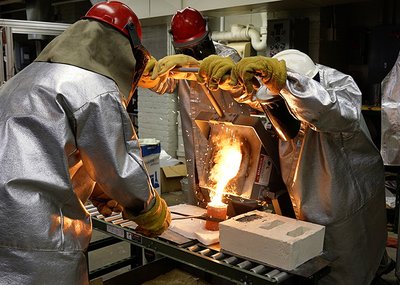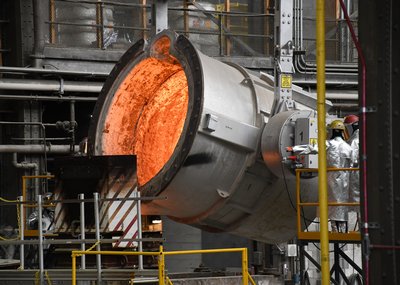Author: Jamie L. LaReau Detroit Free Press
Last November, a small group of scrappy executives from GM Defense LLC quietly called for a meeting with General Motors' board member Wes Bush in a Washington, D.C. office.
The executives of the relatively new GM subsidiary with just 25 employees dedicated to it at that time had a plan to add billions to the automaker's revenues over the next decade by winning military contracts, mostly to develop tactical and combat vehicles. At the time, GM Defense was barely two years old and had not won a single contract.
But in a massive corporation, there's always a battle among divisions for resources and these GM Defense execs knew that Bush — who'd spent most of his career at defense technology company Northrup Grumman — would be a powerful ally.
"He has decades of experience in the defense industry," said Jeff Ryder, vice president of growth and Strategy for GM Defense. Bush was CEO of Northrup Grumman for eight years before joining GM's board in February 2019.
"We sat down with him individually, then briefed the GM board, where he corroborated our business case," Ryder said. "Is there a market? Do we have the capabilities? Is this the right time? The feeling was very strong that GM Defense does have a market and we can win.”
If so, GM stands to add billions to its revenue stream over the next few years. The Department of Defense's annual budget is about $750 billion. Granted, much of that is already spoken for by other companies holding contracts, but GM Defense believes it can grab at least $20 billion in contractsof that money. Those billions would flow right into GM’s earnings before interest and taxation, giving the automaker revenue diversification and additional funding to research its electric and autonomous vehicle technologies beyond relying on sales from pickups and SUVs.
"I do remember, I think it was (GM President) Mark Reuss, at an analyst day in Milford years ago, saying they wanted more defense business but there’s never been much detail nor discussion at earnings time," said David Whiston, Morningstar auto analyst. "This would be a new level and likely good news for GM."
The birth of defense
In 2017, GM formed GM Defense LLC to develop military vehicles that use a variety of the automaker's technologies to protect soldiers, including the advanced mobility and autonomous features GM intends for commercial cars. GM Defense is also working to use its power and propulsion technology, such as fuel cells, for military use.
While the Defense Department's tactical and combat vehicles are the most lucrative targets for GM Defense, it is also considering work with other government agencies, such as the Department of Homeland Security, and even foreign military.
This isn't the first time GM has done business with the defense industry. GM operated a company known as GM Defense from 1950-2003, when it was sold to General Dynamics. But GM's ongoing fuel cell development prompted it to explore the idea of applying technology meant for the commercial car market into potential solutions for the Department of Defense. So in 2010, GM started building a relationship with the U.S. Navy, working on power initiatives for unmanned underwater vehicles.
Through ongoing fuel cell developments with the Army, GM remained linked to the Defense Department even while not having a wholly owned subsidiary until 2017.
Neither Ford Motor Co. or Fiat Chrysler Automobiles has a similar business arm dedicated to the military. But both do general business with the government, including the military.
For example, in October 2019, AM General, a manufacturer of light tactical vehicles, partnered with the Jeep brand to debut a light tactical concept vehicle. The Jeep Gladiator Extreme Military-Grade Truck (XMT) is the first phase of the collaboration for a lightweight military truck. FCA has said, depending on the military’s interest in the Gladiator XMT, production could begin in the second half of 2020. An FCA spokesman declined to comment when asked about the vehicle's production status.
Since last year's meeting with Bush, GM Defense won its first contract, allowing it to eye at least three more bids that carry big paydays if GM wins them.
A launching point
In June, the U.S. Army awarded GM Defense the contract to provide a mobile troop carrier, called the Infantry Squad Vehicle (ISV). It is based on the 2020 Chevrolet Colorado ZR2 pickup.
The contract is worth $214.3 million, peanuts to a multibillion dollar company such as GM, but a big win for GM Defense.
"It puts us on the map with a program the whole industry knows about," Ryder said. "It’s also important for us internally with General Motors. It’s a huge company and in this market environment everything is a competition for resources. You’ve got to earn your value."
The ISV is designed for rapid ground mobility and carrying a nine-soldier infantry squad through the battlefield. The Army is authorized to buy up to 649 vehicles, but the contract would allow it to buy up to 1,070 vehicles from GM Defense over an eight-year period. The Army intends to eventually purchase 2,065 vehicles, GM Defense said. That means the entity could make even more vehicles and money down the road. GM Defense beat out two other finalists for the contract.
GM Defense said the first, low-rate production vehicles will be built in southeast Michigan. But the final production facility has not been chosen.
The contract win is a launching point for GM Defense, allowing it to seek more contracts with more zeros behind them.
"You start to look at some of these larger contracts that would be right up our ally like the Joint Light Tactical Vehicle that is in production with Oshkosh," said Mark Dickens, GM Defense chief engineer. "It was just put up for re-compete" in mid-June.
The $14 billion deal
The Joint Light Tactical Vehicle or JLTV is the new and improved High Mobility Multipurpose Wheeled Vehicle, more commonly called a Humvee.
The Humvee has been in service since the 1980s and there about 140,000 of them in the United States, Ryder said. But the U.S. Army and Marine Corps combat units are replacing the Humvees with high-performance JLTVs — formidable-looking trucks that offer superior crew protection and enhanced performance.
"It’s a major program," Ryder said. "A lot of Humvees were hit in Iraq and Afghanistan, and even though many were up-armored, they left soldiers at risk for lack of a better armored, more capable vehicle."
That gap was filled temporarily by rapidly procured and heavily armored Mine Resistant Ambush Protected vehicles — or MRAPs, Ryder said.
"Much of the heritage of the JLTV, a more capable and survivable vehicle, is in the lessons learned from the Humvees, MRAPs, and the wars of the past decade," Ryder said.
The military wants 49,099 JLTVs, Ryder said. Oshkosh Defense, a tactical vehicle maker, built the first 15,000, but there is a contract to build the other 34,099, Ryder said, "and that’s the part we’re looking at."
GM Defense is conducting a review to determine if it has what it takes to win the JLTV contract, which could last 10 years. The Army’s request for proposal is due in February 2022. It is expected to award the contract in September of that year, Ryder said.
It’s a monumental contract worth $14.5 billion to be paid out over the course of 10 years as vehicles are delivered.
"We think we’d do a great job and it’s our wheelhouse," Ryder said.
He and Dickens said GM Defense needs "past performance" to prove to the army it can build these vehicles. That's where the Infantry Squad Vehicle comes in.
"Without the ISV and that proven performance, those doors are hard to get into," Dickens said. "So this is a key step in our progress to go after programs like this JLTV program.”
Robots on the battlefield
GM Defense is also considering competing for the U.S. Marines Corps' Advanced Reconnaissance Vehicles contract. That program is still in the technology demonstration phase, and the Marine Corps plans to award a production contract in 2024, Ryder said.
That could be another multibillion dollar program over the life of that contract. The length of the contract is unknown, Ryder said, but the vehicle is expected to go into production in 2025.
GM Defense is also investigating the Army's Robotic Combat Vehicle program, Ryder said.
"This is the Army’s plan to introduce robotic vehicles where we currently have manned vehicles like the M1 tank," Ryder said. "The goal is to take soldiers off the platform and have it remotely or autonomously operated. It has sensors and weapons on it but no human beings."
Like the Marine’s Advanced Reconnaissance Vehicle program, this too is in the early testing phases. The Army is still evaluating options on the final requirements for this program and production is expected as early as 2023.
Saving costs and lives
The reconnaissance vehicle would be a game changer because it is expendable since it is unmanned.
"So that brings down the cost of it," Ryder said. "You can use more commercial parts because the vehicle does not have to be as survivable without humans on it. It favors GM because we can leverage our commercial model."
Also, winning these programs would help GM pay to keep developing its autonomous vehicle technology until there is commercial demand for it, analysts say.
"Since these vehicles are so heavily armored and have limited visibility, using AV tech would help improve situational awareness for troops operating the vehicles," said Sam Abuelsamid, principal analyst for E-Mobility at Guidehouse Insights in Detroit. "If GM can apply the technology on these vehicles it would certainly help to recoup some of the billions invested in AVs before they become commercial available at scale."
The long-term potential for all of these types of contracts are multiple billions of dollars, Ryder said.
"I’m not saying it will happen in two or three years, but if you look at 2030, I think you’ll see a lot of robotic vehicles," Ryder said. More importantly, he added, GM Defense wants to work on these types of programs because on the battlefield, "Where you can take human beings out of the operation, you can save lives.”
Schmoozing Washington
Ryder and the GM Defense team know to really grow the business, their networking has to extend beyond the corridors of the company's world headquarters in Detroit.
So the team is consistently lobbying and marketing. GM and GM Defense have been attending the annual Association of the U.S. Army, the premiere army trade show, in the nation's capital since 2016. That's a year before the LLC was formed because of GM's fuel cell development that kept it working with the Department of Defense. . This year it was a virtual show due to the pandemic.
GM Defense had a display there and its leaders networked with customers, potential partners, legislators, international military leaders and the media.
While most of its 50 to 60 GM Defense employees work in southeast Michigan, others such as Jeff Ryder and David Albritton, president of GM Defense, work out of D.C., that's where it's headquartered. But GM Defense also taps GM employees and resources too.
Albritton and Ryder both have defense industry backgrounds. Albritton, who's been GM Defense president since November 2018, is a graduate of the Naval Academy. He served as an officer in the Navy for 10 years. He typically is at the Pentagon or the Capitol meeting with legislators.
Ryder, who speaks Russian and Uzbek from an early career in the Peace Corps, spent a year as the chief strategy officer at Exelis, a global aerospace, defense and information solutions company. In 2015, he founded Glacier Point where he consulted to government contractors, he said.
"I have a background understanding how the government works, what it needs and what it buys," Ryder said.
Kick the tires
GM Defense has other allies on GM's board other than Bush. Former CIA official and CEO of Kissinger Associates Judith Miscik was elected to the board in October 2018. Kissinger Associates is a consulting firm, founded by former Secretary of State Henry Kissinger, that advises in government relations.
Also, Linda Gooden, a retired executive from Lockheed Martin Corp., an aerospace, defense, arms, security, and advanced technologies company, was first elected to the board in 2015.
"All three of those directors were appointed under CEO Mary Barra, not (former CEO) Dan Akerson, who had a military background," said Morningstar's Whiston.
But during Akerson's tenure, Michael Mullen, a retired admiral and the 17th chairman of the Joint Chiefs of Staff, served on GM's board. He retired in April 2019.
"The defense reps are good for government contacts and also may have technology contacts," Whiston said. "That can be helpful to GM’s AV technology."
The board members' support is "hugely" important to GM Defense because they understand its mission, Ryder and Dickens said.
“We’re in an adjacent business for GM," said Dickens. "General Motors is in a $135 billion (annual revenue) company making commercial cars and trucks. That’s what GM knows. We’re in a different market and there are a lot of very specific attributes of a government system."
GM Defense's Infantry Squad Vehicle captured the attention of GM's top brass last fall.
In September 2019, as GM Defense prepared to ship the ISV to the Army for evaluation, Reuss headed to GM's Milford Proving Grounds to see it. There, Reuss jumped in and took it for a spin. A few months later, Barra and other leaders did a final walk around the vehicle before it was sent off.
None of it was not lost on the GM Defense team.
"It says a lot that, right before you offer your first vehicle to the military, the president of the company comes and kicks the tires," Ryder said. "That says we have the support of the company."









